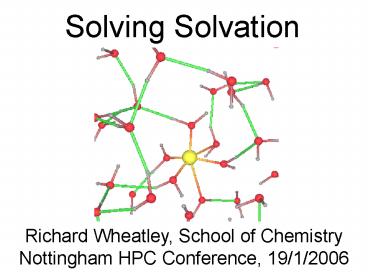Solving Solvation - PowerPoint PPT Presentation
1 / 15
Title:
Solving Solvation
Description:
Related to the intermolecular potential energy surface (binding energy as a function of coordinates) ... can be calculated from the intermolecular potential. ... – PowerPoint PPT presentation
Number of Views:50
Avg rating:3.0/5.0
Title: Solving Solvation
1
Solving Solvation
Richard Wheatley, School of Chemistry Nottingham
HPC Conference, 19/1/2006
2
Research Goals
Related to the intermolecular potential energy
surface (binding energy as a function of
coordinates)
- Calculate potentials.
- Electron structure.
- Perturbation theory.
- Nuclear dynamics.
- Quantum dynamics.
- Classical dynamics.
- Virial coefficients.
3
Electron structure
The electronic Schrödinger equation (Ke Vnn
Vne Vee) ?e Ee ?e
Ke
Many electrons, therefore ?e is a function of
many coordinates.
Vne
Vee
Ke
Vne
The orbital approximation ?e det ?1, ?2,
?3 where ? are molecular orbitals (one per
electron)
4
Electron structure
Then calculate the energy by minimising Ee ? ?e
(Ke Vnn Vne Vee) ?e dre with respect to
variations in the molecular orbitals. The Vee
integrals are the most numerous N4 integrals of
the form ? ?1(r1) ?2(r1) ?3(r2) ?4(r2) r121
dr2 Beyond the orbital approximation, things get
worse HF/SCF/DFT (orbital approximation) CPU
time N4 MP2 CPU time N4n (n number of
electrons) CCSD N4n2 CCSD(T) N4n3
5
Electron structure
The supermolecule method.
For two molecules A and B, the intermolecular
potential V(AB) is calculated as V(AB) Ee(AB)
Ee(A) Ee(B). This needs one calculation for
each of many different (100s-1000s)
intermolecular coordinates.
The calculations work well in
parallel. Well-defined, simple
procedure. Existing, optimised computer programs
(Molpro). Requires lots of computer time. Only
CCSD(T) is accurate enough. Memory may also be an
issue.
6
Perturbation theory
The SIMPER method.
For two molecules A and B, the intermolecular
potential V(AB) is calculated as V(AB)
Velec(AB) Vind(AB) Vdisp(AB)
Vexch(AB). This also needs one calculation for
each of many different (100s-1000s)
intermolecular coordinates.
The calculations work well in
parallel. Scaling is like MP2, not
CCSD(T). Not as accurate as CCSD(T). Dispersion
is particularly difficult. Computer programs are
not optimised. (We have tried to address these
concerns!)
7
Perturbation theory
Dispersion energy coefficients.
For large separations (R) between A and
B, Vdisp(AB) C6 R6. The coefficient C6 can
be calculated from the frequency-dependent
polarizabilities a. C6 ? aA(i?) aB(i?)
d? Calculating the polarizabilities is demanding
(CCSD) in computer time and memory, but only
needs to be done once, not once per
intermolecular coordinate. Different frequencies
? can be treated in parallel. (A higher level of
parallelism may be useful!)
8
Nuclear dynamics
The nuclear Schrödinger equation (Kn V(AB)) ?n
Etotal ?n Complicated intermolecular potential
V(AB).
There may be few or many coordinates.
v
r
Few coordinates exact solution
(spectroscopy). Many coordinates approximations
(thermodynamics).
9
Quantum dynamics
For exact solutions, calculate the energy by
minimising Etotal ? ?n (Kn V(AB)) ?n drn with
respect to variations in the nuclear wave
function. This involves calculating a large
number of integrals and then solving a large
matrix problem to obtain the variational wave
functions and energies. Obtaining eigenvalues
(and eigenfunctions) of the large, (sparse),
(expensive) matrix is the computationally
intensive step. Parallel algorithms? Done for
H2O-atom interactions. Work planned for H2O-N2
and H2O-O2.
10
Classical dynamics
For approximate solutions, replace the
Schrödinger equation by Newtons equations (F m
a, F ?V(AB)). Solve Newtons equations by
propagation in time. ? Molecular
Dynamics. Efficient, parallel algorithms are
known. Our interest is mainly in developing more
accurate intermolecular potentials (as already
described) for Molecular Dynamics
simulations. Calculating the forces (and indeed
torques) on the interacting molecules is the
rate-determining step. Memory is not a problem
ideal for the HPC cluster.
11
Virial coefficients
In a Molecular Dynamics simulation of a system at
equilibrium, on average, the relative probability
P of occurrence of different arrangements of the
molecules follows the Boltzmann law, P
exp(V(AB)/kT). This information can be used to
predict the equilibrium thermodynamics of a
system without using Molecular Dynamics
simulations (evaluate V(AB), not
derivatives). High-density systems (solids and
liquids) can be simulated using the Monte Carlo
method. For low-density systems (gases), use a
virial expansion of the properties of the system
in powers of the density.
12
Virial coefficients
P/kT ? B2? B3?2 B2 (and the other virial
coefficients) can be calculated from the
intermolecular potential. B2 ? 1
exp(V(AB)/kT) dr / 2 For 2 polyatomic molecules
the integral is 6-dimensional and the calculation
can easily be done in parallel. Higher virial
coefficients require increasing effort, e.g. B8
requires 7,123 18-dimensional integrals just for
atoms. Efficient methods of calculating Bn place
moderate demands on memory and
high demands on CPU time.
13
Recent results
Intermolecular potentials and second virial
coefficients for H2O-N2 and H2O-O2, using
supermolecule and perturbation calculations
(SIMPER). Supermolecule calculations for CO2-H2O,
CO2-CO2, CO2-CH3F, CO2-CH2F2 and CO2-CHF3
(MP2). Dispersion energy coefficients from C6 to
C16 for a number of interactions including the
above. Quantum nuclear dynamics and predicted
spectra for Ne-HCl, Ar-H2O and Ar-HCl. Virial
coefficients from B2 to B7 for the complete range
of inverse-power potentials V(AB)Rn.
14
Future work
Intermolecular potentials for a range of small
organic molecules, using supermolecule
calculations, perturbation theory and
transferability. Molecular Dynamics using these
potentials. Intermolecular potentials for
interactions of nitric oxide (NO) with other
molecules. Dispersion energy coefficients from C6
to C10 for atoms within molecules required for
larger molecules. Quantum nuclear dynamics and
predicted spectra for systems involving two
polyatomic molecules, including H2-H2O and NO-N2.
Virial coefficients from B2 to B7 for mixtures
of particles with different inverse-power
potentials V(AB)Rn.
15
Thanks
Funding EPSRC The Leverhulme Trust The Royal
Society US National Institute of Standards and
Technology University of Nottingham People Matt
Hodges Elena Bichoutskaia Akyl Tulegenov

